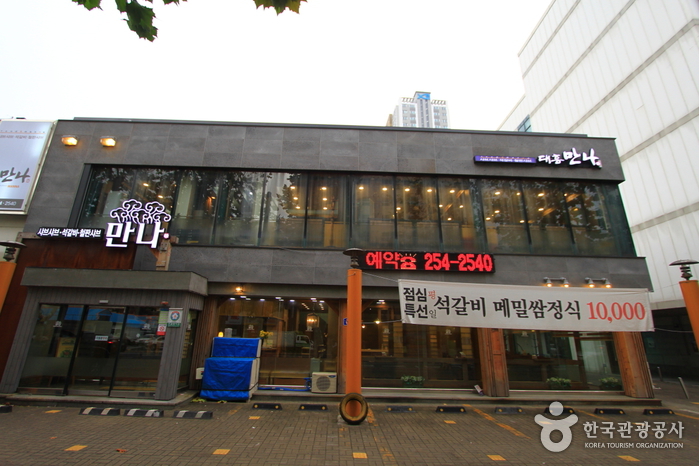Artbox - Daejeon Eunhaeng Branch [Tax Refund Shop] (아트박스 대전은행)
12.7Km 2024-04-22
29, Daejong-ro 488beon-gil, Jung-gu, Daejeon
-
Daejeon O-World (대전오월드)
12.7Km 2022-12-27
70, Sajeonggongwon-ro, Jung-gu, Daejeon
+82-42-580-4820
Daejeon O-World was established when the Daejeon Zoo and Joy Land, an amusement park, were integrated under the supervision of the Daejeon City Corporation. The project cost a whopping 40 billion won and resulted in the construction of Flower Land (100,000㎡) in addition to the renamed Zoo Land and the preexisting Joy Land. It opened on May 1, 2009 to the public.
The three main sections of Daejeon O-World are Zoo Land, Joy Land, and Flower Land. Zoo Land is currently home to a total of 600 animals of 130 different species including American black bears, Bengal tigers, lions, elephants, giraffes, zebras, and ostriches. Amusement rides, waterslides, and four-season sledding are housed at Joy Land. Flower Land boasts a number of smaller sections such as Rose Garden, Four Season Garden, Herb Garden, and Maze Garden and is home to a total of 150,000 tress of 100 different species and 200,000 flowers of 85 different species. An outdoor stage and concert hall are also located in the area.
There are plenty of things to see and enjoy in every corner of Daejeon O-World. Just beyond Festival Street, visitors will find a large (3,000㎡) pond with a fountain.
Frisbee - Daejeon Branch [Tax Refund Shop] (FR대전점(금강 프리스비))
12.7Km 2024-04-22
166, Jungang-ro, Jung-gu, Daejeon
-
Sungsimdang (성심당)
12.7Km 2024-10-28
15 , Daejong-ro 480beon-gil, Jung-gu, Daejeon
+82-42-254-4114
Sungsimdang was first established as a small bakery selling jjinbbang (steamed bun) in front of Daejeon Station in 1956, and has since become an iconic bakery that represents Daejeon as well as Korea's baked goods. Baked goods at Sungsimdang are all handmade using quality ingredients and reach almost 400 in variety, including breads that uses slow-bread process which requires a 16-hour fermentation.
E-Mart - Sejong Branch [Tax Refund Shop] (이마트 세종)
12.7Km 2025-05-20
2F, 10, Docheong-ro, Yeongtong-gu, Suwon-si, Gyeonggi-do
-
Olive Young - Daejeon Jungang Branch [Tax Refund Shop] (올리브영 대전중앙점)
12.8Km 2024-06-27
17, Jungang-ro 164beon-gil, Jung-gu, Daejeon
-
Miso Bonga Smile Kalguksu (미소본가스마일칼국수)
12.8Km 2024-02-23
82 Bomun-ro 230beon-gil, Jung-gu, Daejeon
042-221-1845
Miso Bonga Smile Kalguksu is renowned for its kalguksu (noodle soup), featuring handmade noodles. The dish presents a noodle soup rich with ingredients such as anchovy broth, crown daisy, ground perilla seeds, and zucchini. Popular summer dishes include son kongguksu (noodles in cold soybean soup), suyuk (boiled pork slices), and the crispy kimchijeon (kimchi pancake), which are also favorites among patrons. This place is so popular that you may find yourself waiting in line.
Banchan Sikdang (반찬식당)
12.8Km 2024-02-15
484 Bomunsangongwon-ro, Jung-gu, Daejeon
Situated at the gateway to Bomunsan Mountain, Banchan Sikdang is known for its expertise in steamed barley rice. This dish is typically presented with vegetables and red chili paste, and it's mixed with a choice of either perilla or sesame oil, enhancing its flavors. The restaurant's standard side dishes include biji jjigae (pureed soybean jjigae), doenjang jjigae (soybean paste jjigae), and gyeranjjim (steamed eggs). Additionally, their savory green onion pancake, enriched with squid and chives, is a highly recommended specialty.
Yussine Bueok (유씨네부엌)
12.8Km 2024-02-15
109 Bomunsangongwon-ro 497beon-gil, Jung-gu, Daejeon
Yussine Bueok, situated at the gateway to Bomunsan Mountain, is a shabu-shabu restaurant. The standout item on the menu is the Beoseot shabu shabu (mushroom shabu-shabu), featuring an assortment of mushrooms and vegetables. In this dish, the meat, vegetables, and mushrooms are delicately cooked in a light broth, allowing their natural flavors to shine. After enjoying the meat, diners can choose to stir-fry rice in the remaining broth or add noodles and eggs to create a hearty porridge. Another popular choice at Yussine Bueok is the Eongttung shabu shabu, notably served with gorgonzola pizza, adding a delightful fusion twist to the traditional shabu-shabu experience.
Manna (만나)
12.8Km 2024-02-15
138 Daeheung-ro, Jung-gu, Daejeon
Manna is a renowned restaurant known for its sukiyaki, a traditional Japanese dish. This dish boasts a delightful combination of beef, vegetables, mushrooms, and fish cakes, all simmered in a delicate broth. Typically, the cooked ingredients are dipped in raw egg, which adds a rich and creamy texture. Alternatively, the cooked meat can be dipped in ssamjang (mixed paste) and wrapped in lettuce. Complementing the meal, lemonsawa (a mix of soju or sake with lemon juice) pairs well with sukiyaki. The experience is often rounded off with lemon tea, providing a refreshing and soothing conclusion to the dining experience.
![Artbox - Daejeon Eunhaeng Branch [Tax Refund Shop] (아트박스 대전은행)](http://tong.visitkorea.or.kr/cms/resource/07/2883607_image2_1.jpg)

![Frisbee - Daejeon Branch [Tax Refund Shop] (FR대전점(금강 프리스비))](http://tong.visitkorea.or.kr/cms/resource/17/2883617_image2_1.jpg)
![E-Mart - Sejong Branch [Tax Refund Shop] (이마트 세종)](http://tong.visitkorea.or.kr/cms/resource/70/2883170_image2_1.jpg)

 English
English
 한국어
한국어 日本語
日本語 中文(简体)
中文(简体) Deutsch
Deutsch Français
Français Español
Español Русский
Русский